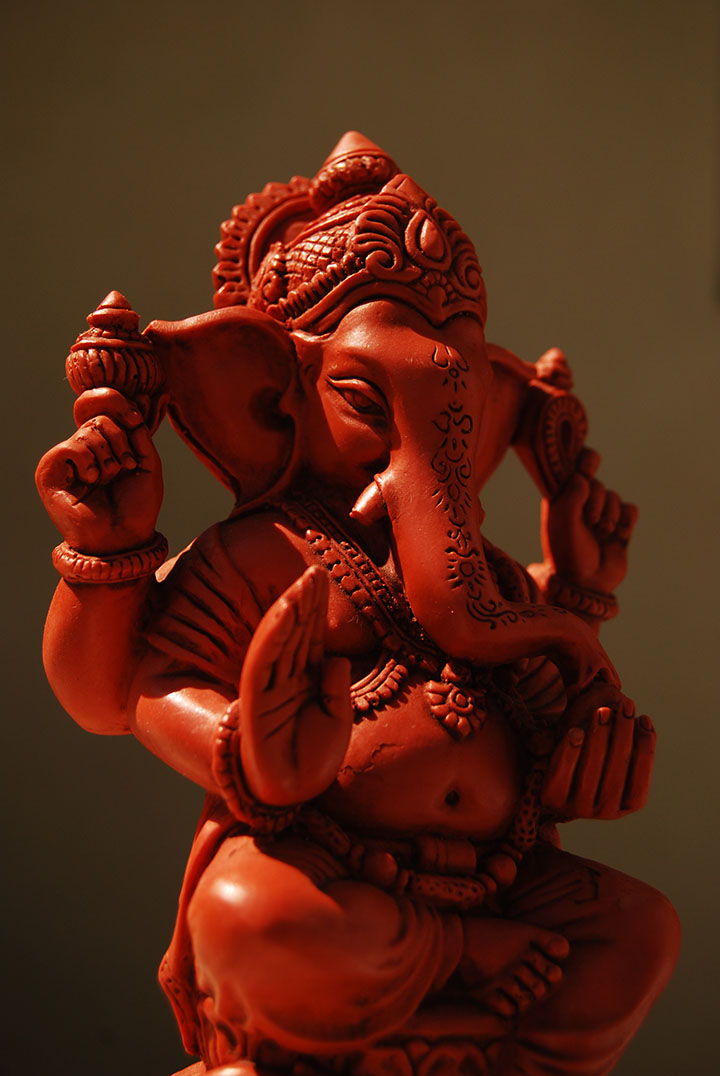The use of sacred chants has become incredibly popular since 2013, when Oprah and Deepak Chopra launched their first of what would become a successful series of 21 day meditation challenges. As an assignment from my PhD professor back then, I began following the global phenomena to report back about what was being used as tools for the participants. The experiences focused on a variety of wellness topics ranging from self-love to manifestation. Each day recipients received encouraging thoughts by Oprah followed by a new mantra each day presented with little explanations from Chopra. He would then lead a meditation with background music and bring the listeners back to the present moment with the sound of chimes.
As a master’s student studying the language of Sanskrit, I was trained to understand the potency and power of this ancient mother tongue. My professors were very particular and taught me the importance of perfect pronunciation. They remain a valued friends and teachers as I continue to study, publish and teach this topic.
When I questioned my one of my professors about the mispronunciation presented in the meditation challenge style I had encountered—my esteemed professor said this to me:
Imagine you are standing on the threshold of a door. It is an obstacle you wish to get through. On the other side is great healing or knowledge you crave. In your hand is a ring of keys. One of these could potentially open up that mystical door. The transcendence you hunger for is on the other side of that door and the proper mantra can open it. When you mispronounce the mantra that you think is correct or use it at the wrong time, you will never be able to get it to open. Instead, you stand there jiggling the keys and cannot get it into the lock. Mispronunciation can not only prevent entry—it can cause harm.
Ancient cultures have known the healing power of sound for centuries. In the beginning there was sound. This is found in all of the ancient scriptural books. I have been taught the transcendent nature that properly pronouncing the word Samskrutham —which is the way to say the name of the language Sanskrit—activates the pineal gland in such a way, that it can urge a release of the sweet nectar known as Ojas. This mystical essence translates to splendor, vitality, power, luster, appearance, and bodily strength. You can think of Ojas as the container that holds your happiness. It is the purest essence of Kapha Dosha one of the Ayurveda qualities of the body’s humors. In the physical body, Ojas is related to the reproductive, hormonal, and cerebrospinal fluids.
A sound just like a smell can induce an instant reaction
As a very young yogi, I learned in study of the ancient Vedic text known as the Upanishads, that each sound from the Sanskrit alphabet resonates and vibrates with one of the corresponding fifty petals of the first six chakras. These profound energy centers are anchors of layers that compose our bodies, minds, and spirits. Try to imagine these as multi-dimensional rather than thinking of them as flat discs, spinning like wheels. Yes, in the two dimensional artwork we see chakras imagined to be like flat disclike lotus flowers, each possessing specific numbers of petals. We can also see this idea expressed in the more modern Huangdi Neijing known as The Yellow Emperor’s Classic of Medicine in the modern translations of the text.
Keep in mind that in the ancient times there were no autopsies performed. Therefore, the culture did not know what the organs looked like and imagined them to be like multi petaled flowers as well. Perhaps this interpretation came by way of the ancient artwork of the chakras?
In the model of the chakra petals we focus on the fist six chakras. The first chakra, Muladhara Chakra, commonly called the root chakra has four petals with four corresponding sounds. There are six sounds for the petals of Svadhishthana Chakra, the second and ten held in the third, Manipura Chakra. Anahata Chakra, the fourth in the location of heart center, carries 12 sounds and Vishuddha Chakra, the fifth chakra of the throat has 16 petals. The Third eye, Ajña Chakra carries the final two in its scarab like shape. The seventh chakra, Sahasrara Chakra, known as the Crown Chakra has 1,000 petals. It is seen as the highest spiritual point and is beyond this reality. It is not included in this progression.
I know that Oprah and Chopra had good intentions when they set out to create their programs, but in the mishmash of mantras what I perceived happening was the creation of a toxic sound-soup of confusion. My professors concurred. Before you become frustrated by this, please allow me offer some explanation. Let us please keep in mind that we are only scratching a bit of the surface here. Yes, you may feel like you are going back to the beginning on some concepts that you already know. I do hope to shed light upon any you may have missed or forgotten.
Vak-yoga is the Vedic name of Samskrutham. This adds another layer of mystery to a much more vast amount of knowledge. Now, let us consider that when we want to open a path, alter a mood, or fully change course—that it is a good idea to utilize the correct key and to be standing at the intended door at the best possible time.
The classical phrases and recommended articulations were first passed on by voice to voice, ear to ear and taught only in this way. This insured precision and patience. Tone, rhythm, and timing are all key components. It was not until much later that any idea of written language was etched into leaves and later inked upon paper to capture these teachings.
In a seeming game of broken telephone—a game children play whispering a single phrase to then be passed through a succession of ears—has resulted in much the same way. An indistinguishable garble at the end. Let us all make an effort to be more mindful of this and continue to dive deeply into this knowledge.
It has now become popular to refer to Vak-yoga as Mantra-yoga. You can begin learning more about Vak-yoga, the teaching brand of Yoga-Samskrutham University http://www.ysam.org/
Learn even more about proper pronunciation of the language which is Vag-yoga in this video:
Now we have identified that sacred mantras are composed of particular sounds with precise rhythms and intonations to be used at specific times of day or night. The precise choosing of a moment in time is measured by Jyotisha, a sister discipline to yoga. This is the science of light also known as astrology.
Yes, the timing of when to use any given sound-sequence holds tremendous importance. In order to choose this demands a great understanding of the cosmic ruler-ship of each day, hour, and minute. Consideration must also be taken as to when the mantra is to be chanted and for what purpose. This is a science and not a free-flowing art-form. Every moment is ruled by specific energies of the universe.
To engage the full power of chanting a mantra is to practice a transcendental form of Yoga. Therefore, these sacred utterances can be considered as mysterious invocations designed to shift the energy of the practitioner, those listening, the local environment, and the totality of the reality perceived around them. A mantra can therefore be imagined to be a form of supernatural manipulation as these yoga practitioners have the power to intervene with the cosmos, the fortunes of individuals, and Mother Nature’s processes. This is why those not understanding the full force of mantra-yoga can be mistaken for spell-casters and sorcerers.
The Latin languages utilize a great deal of sounds as well as grammar from Sanskrit. We can see this in the etymology of many words in our own mother tongue of English. Given the principles we are now decoding—I hope that we can now agree—that every single shaping of syllables through the use of our very sacred Throat Chakra, is a potentially, powerful architect. In addition let us realize now that thought is a matrix Creatrix.
Let’s go on a little journey. Imagine the first pop of an idea that is to become a spoken utterance. It happens so quickly that we do not even have time to grasp the moment—unless we are in the state of meditation. In order for this seed-idea to become a word, the original impression must dive down to the center of the heart-space—the chamber of the unstruck sound—to collect air from the lungs. Next, as it gains momentum the magickal1 seed, becomes a single syllable, a fragment of—or complete thought to be expressed as a word. The original spark travels onward to exit through the mouth. On its way there, the smooth tissue of the vocal cords strike together. This sets off a sequence of oscillations that could be full of grace and curative, or disharmonious, causing distress. Think of the photography experiments of the brilliant Dr. Masaru Emoto. He discovered the shapes of sounds which are the Vedas refer to as Yantras expressed in his perfect, frozen sound images. https://www.masaru-emoto.net/en/
To learn more about this, I suggest reading these two books by Dr. Emoto entitled, The Hidden Messages in Water, and The True Power of Water. If you have not seen the film. What the Bleep Do We Know it, you might find that interesting as well.
Another film I often suggest to my students and is, The Connected Universe, by Nassim Haramein. (movie link to IMDB: https://www.imdb.com/title/tt6108612/) Also be sure to look into his work with the Resonance Science Foundation. https://www.resonancescience.org
Let us continue to follow the path of sound and consider that the sounds we make not only vibrate specific patterns of petals in the system of dynamic anchors strung together to form the chakra system —they also circulate back into our own heads, thereupon influencing our bodies, minds, and spirits.
Now let’s ask ourselves, What occurs when a phrase has great intention and it is mispronounced? I hope this is expanding your enthusiasm to create positive and correct sounds in any practice such as Mantra-yoga. Does it now make sense that both thought and the formulation of sound affects everything?
Just in case you feel any discouragement, I have good news for you. We can begin gently to explore these concepts and to gain sensation with them while avoiding any possible mistakes. This is a gentle exploration of your body as an instrument of sound. To do this we are going to use vowel sounds along with specific consonants to safely to produce bodily-felt sensations. This gives you the opportunity to prove and know the full effects of your own voice.
Here is something you can try
Place yourself in a very quiet environment, free from electronics and distractions. This is preferably 30 feet from WiFi and Bluetooth devices. Place your body in a comfortable seated position with your back as straight as possible. If this is not available to you, it is okay to be in a reclining position as long as your breathing path is clear. It is most important to feel relaxed.
Begin by exhaling and then by taking a few very long, deep, cleansing breaths in and out through your nose. Once you feel that you are able to breathe deeply, progress to the next step.
Now, use the exhalation following one of your deep breaths in through your nose to make the sound “uh”. Tum out through your mouth. This short vowel sound is pronounced, “uh” as in the words bug and cup. As you make this sound, allow your tongue to gently strike the soft tissue of the roof of the mouth, just behind the teeth rather than directly against the teeth. Repeat this for a minimum of four times. As you practice this, consciously become aware of the sound inside your body. Be neutral as you observe this and know that there is no right or wrong way. Continue to consciously experience the silence outside of your physical body.
Let each sound to go out slowly and fully without force. Gently allow the sound to taper off on its own through natural nasalization as your lips close towards the end of the audible sound. Experience the trailing off of each sound like the tapering off of the ringing of a bell or gong. Follow the dissipating sound as it disappears. After each sound ends, experience the totality of the silence. Allow yourself ample time to engage with the bubble of energy this has created. Observe it.
Take the next breath. Continue in the sequence as many times as you desire. Each time becoming the witness.
Next repeat the practice just as before with a new sound “ah” Tam. The vowel sound is, “ah” as in the word log and bog. Go through the same sequences as before with this new sound. Observe as you did before, soaking in the effects.
Here is a website with examples of the two vowel sounds for further guidance.
https://sandiegovoiceandaccent.com/videos/how-to-pronounce-the-ah-%C9%91-vowel-and-the-uh- %CA%8C-vowel
It is very important to only use the sounds explained here for this particular experiment. Please do not use other sounds as this is a specific practice that originates from Yoga-Samskrutham University, http://www.ysam.org/ and is an outreaching from Yoga teachings that are rooted the Bhagavad Gita and in Patañjali writings.
Please write in your journal in response to the following questions
Analyze the state of your body before, during, and after the experience of each sound. Ask yourself if it is relaxed, tense, or neutral? What do you sense? Pay close attention to any and all changes.
Likewise, monitor your sensations of your breathing and its capacity before, during, and after each experience. Ask yourself if it seems normal, slowed down, or modified?
Further, observe the state of the mind2 before, during, and after this sound experiment. Ask yourself whether it seems more calm, peaceful, or joyous?
Are you feeling inspired? I hope so! May we all become more aware of the words we use everyday in speech about ourselves, others, and our environment. Let us remember that pronunciation and timing matter especially when we expect to receive particular outcomes when using practice of Vak-yoga. The information I have shared with you here is just a launch-point for the vast science of sound, that is a substantial cornerstone supporting the philosophy of Yoga.
Ambika Devi
Ambika Devi is an international award winning best-selling author, expert astrologer, meditation Jedi, speaker and storyteller on a peace mission to help you step out of the churning river of thoughts and activity of the mind, stop wearing insane schedules like badges of honor, and begin your days reinforced with the calmness a meditation practice brings. Visit her at:
AmbikasCoaching.com




